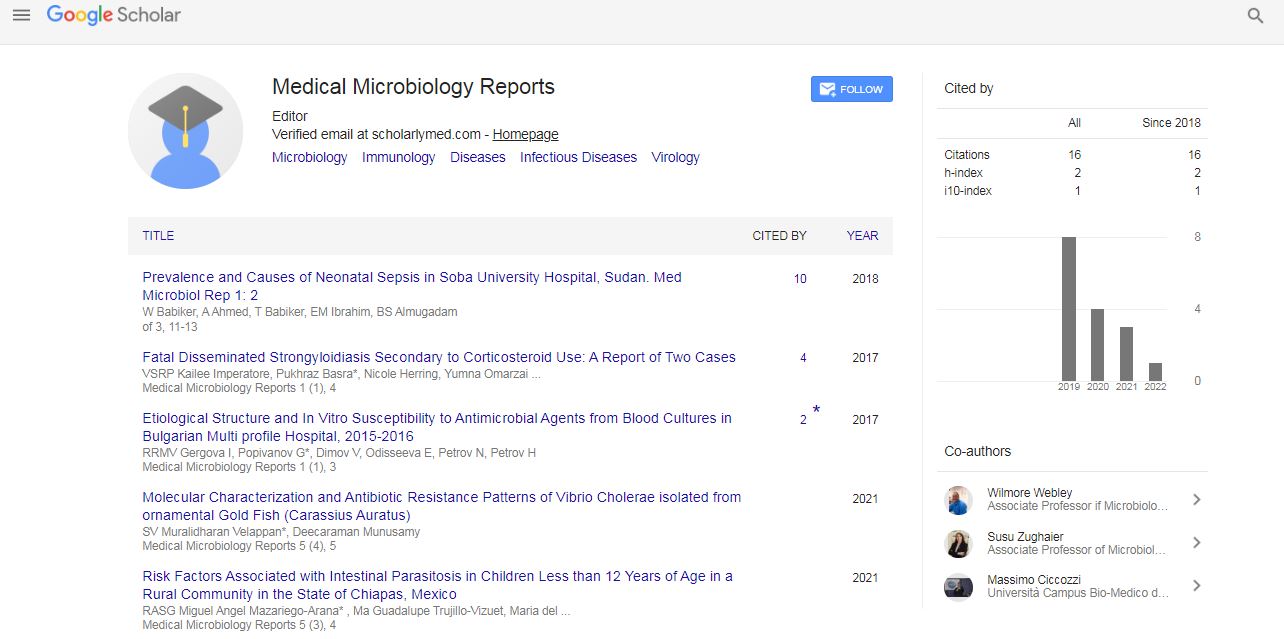Short Communication, Med Microbiol Rep Vol: 7 Issue: 4
Managing the Obstacles and Advances of Virological Analysis
Perelle Hennechart*
1Department of Experimental Medicine, University of Rome, Rome, Italy
*Corresponding Author: Perelle Hennechart,
Department of Experimental
Medicine, University of Rome, Rome, Italy
E-mail: perelhennech@gmail.com
Received date: 24 November, 2023, Manuscript No. MMR-24-128536;
Editor assigned date: 27 November, 2023, PreQC No. MMR-24-128536 (PQ);
Reviewed date: 11 December, 2023, QC No. MMR-24-128536;
Revised date: 18 December, 2023, Manuscript No. MMR-24-128536 (R);
Published date: 26 December, 2023, DOI: 10.4172/MMR.1000352
Citation: Hennechart P (2023) Managing the Obstacles and Advances of Virological Analysis. Med Microbiol Rep 7:4.
Description
Virology, the scientific study of viruses, is at the core of the understanding of infectious agents that can profoundly impact human health, agriculture and ecosystems. Simultaneously, it embraces a spectrum of advances driven by technological innovations and interdisciplinary collaboration. Developing the complex equilibrium between challenges and progress in virological analysis is important for overcoming challenges of viruses and developing effective strategies for prevention and treatment. One significant obstacle in virological analysis lies in the complex in nature of viral structures. Unlike living cells, viruses lack the cellular machinery necessary for independent life. Instead, they consist of genetic material encapsulated in a protein coat, sometimes surrounded by a lipid membrane [1,2].
The extreme variation in viral structures poses a formidable challenge in studying and characterizing different viruses. Electron microscopy, cryo-electron microscopy and X-ray crystallography have emerged as powerful tools in overcoming this obstacle, allowing analysts to visualize the complex details of viral particles at the nanoscale. The constant evolution of viruses presents another formidable challenge. Viruses are masters of adaptation, with high mutation rates that enable them to evade host immune responses and develop resistance to antiviral drugs. This adaptability is particularly evident in Ribonucleic Acid (RNA) viruses like influenza and Human Immunodeficiency Viruses (HIV). Analyzing and understanding the evolution of viruses require sophisticated genetic and computational analyses. Advances in next-generation sequencing technologies have revolutionized virological analysis, enabling rapid and comprehensive genomic analysis of viral populations [3,4].
The host-virus interaction adds another layer of complexity to virological analysis. Viruses rely on host cells to replicate and propagate, and the complex twirl between the virus and host immune responses shapes the course of infection. Interpreting this complex interaction involves revealing the molecular mechanisms underlying viral entry, replication and immune evasion. Advanced techniques, such as CRISPR-based genetic editing and single-cell RNA sequencing, empower analysts to dissect the complexities of host-virus interactions at a granular level. Within the field of diagnostic virology, timely and accurate detection of viral infections is paramount for effective disease management. However, the diversity of viruses and their capacity to follow in other illnesses pose challenges in developing universal diagnostic tools. Polymerase Chain Reaction (PCR) and nucleic acid-based assays have been pivotal in virological diagnostics, providing sensitive and specific detection of viral genetic material [5-7].
The global spread of viral infections, as witnessed with pandemics like COVID-19, highlights the need for rapid and scalable approaches in virological analysis. Epidemiological studies, contact tracing and surveillance demand real-time data collection and analysis. Data science and artificial intelligence play a vital role in managing this challenge, facilitating the prediction of viral spread patterns, assessing the impact of interventions and optimizing public health responses. Advances in antiviral therapies and vaccine development represent outcomes in virological analysis. The obstacles of viral diversity and rapid mutation are met with innovative strategies, such as broadspectrum antivirals customizing conserved viral components and mRNA-based vaccines that can be rapidly adapted to emerging viral variants [8-10].
Conclusion
The development of new technologies, such as habitat for particles that resemble viruses and viral vector vaccines, broadens the arsenal of tools available for combating viral infections. Interdisciplinary collaboration emerges as a key driver of progress in virological analysis. The integration of expertise from virologists, immunologists, bioinformaticians and clinicians develops a comprehensive understanding of viral diseases. Collaborative efforts facilitate the translation of basic analysis findings into practical applications, accelerating the development of diagnostics, therapeutics and vaccines. In, managing the obstacles and advances in virological analysis is a dynamic and ongoing process. The complex structures of viruses, their adaptive evolution and the complex interplay with host cells present formidable challenges.
References
- Chuard C, Reller LB (1999) Diagnostic value of gram stain and culture of sputum and endotracheal aspirates in bacteremic pneumococcal pneumonia. Clin Microbiol Infect 5:106-109.
- Joseph NM, Sistla S, Dutta TK, Badhe AS, Rasitha D, et al. (2010) Role of semi-quantitative and quantitative cultures of endotracheal aspirates in the diagnosis of ventilator-associated pneumonia. Aust Med J 3:627.
- Pawar M, Mehta Y, Khurana P, Chaudhary A, Kulkarni V, et al. (2003) Ventilator-associated pneumonia: Incidence, risk factors, outcome, and microbiology. J Cardiothorac Vasc Anesth. 17:22-28.
- Klompas M (2007) Does this patient have ventilator-associated pneumonia? JAMA 297:1583-1593.
- Skrupky LP, McConnell K, Dallas J, Kollef MH (2012) A comparison of ventilator-associated pneumonia rates as identified according to the national healthcare safety network and American college of chest physicians criteria. Crit Care Med 40:281-284.
- Akobi OA, Inyinbor HE, Akobi EC (2014) Incidence of urinary tract infection among pregnant women attending antenatal clinic at federal medical centre, Bida, Niger-State, North Central Nigeria. Am J Infect Dis Microiol 2:34-38.
- Smaill F, Vazquez JC (2007) Antibiotics for asymptomatic bacteriuria in pregnancy. Cochrane Database Syst Rev CD000490.
- Edae M, Teklemariam Z, Weldegebreal F, Abate D (2020) Asymptomatic bacteriuria among pregnant women attending antenatal care at Hiwot Fana specialized university hospital, Harar, Eastern Ethiopia: Magnitude, associated factors, and antimicrobial susceptibility pattern. Int J Microbiol 2020:1763931.
- Colgan R, Nicolle L, McGlone A, Hooton T (2006) Asymptomatic bacteriuria in adults. Am Fam Phys 74:985–990.
- Schnarr J, Smaill F (2008) Asymptomatic bacteriuria and symptomatic urinary tract infections in pregnancy. Eur J Clin Invest 38:50-57.
 Spanish
Spanish  Chinese
Chinese  Russian
Russian  German
German  French
French  Japanese
Japanese  Portuguese
Portuguese  Hindi
Hindi 
